Happy Onam !!! So today is the first day of Onam – Onnam Onam or Utradam – the start day of 4 days of festivities. Clean up and get ready for the main festivities the next day – the Thiruvonam. No major sadya today, just a couple traditional dishes and of course the desert is a Payasam. Today the paysam of choice is Cheru Parippu Payasam, specifically Parippu Pradhaman. 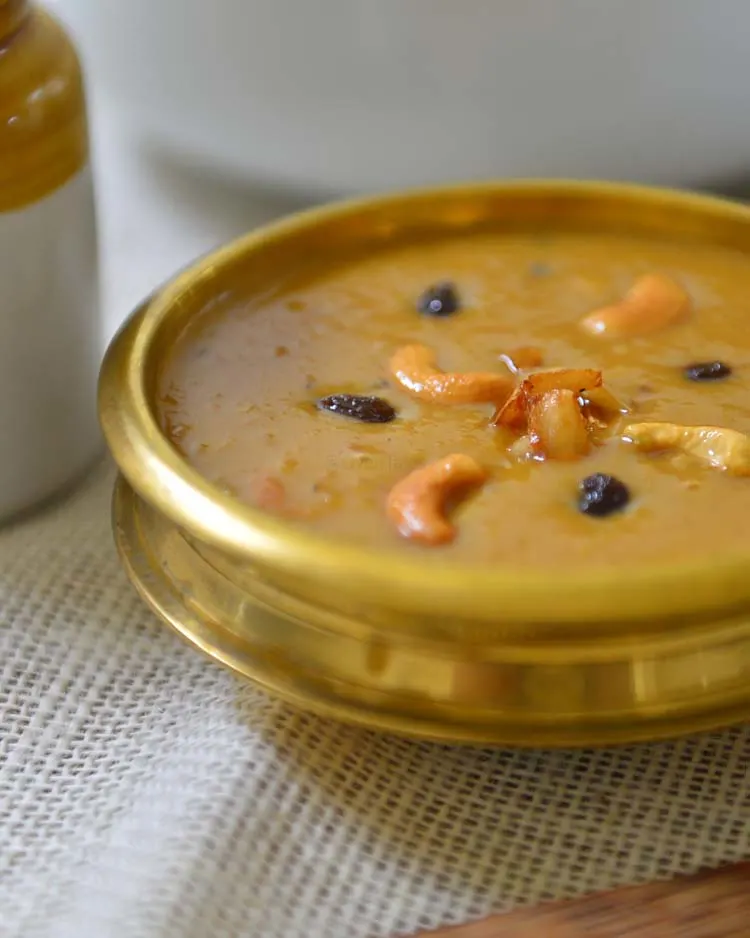
If you are new to Indian food – think of payasam or kheer as a soupy desert! It is a sweet dish served in a semi liquid form. I always start out thinking that I should make payasam on all 4 days of Onam, but usually by the 3rd day the sugar overload tajes over:-) . Moderation when it comes to payasam is something I have yet to master !
Pradhamans fall into a special category of payasams that are very vegan friendly ! The sweetener is jaggery, the liquid base is coconut milk and the star ingredient could be fruits, nuts , beans, rice or wheat. Today it is split mung beans or cherupayar parippu. The only non vegan ingredient is ghee – used for frying the garnishes . This is an easy fix – swap out the ghee for coconut oil or any flavorless oil , or dry roast the garnishes. Coconut milk , beans, jaggery (evaporated pure cane juice) these are all ingredients that the nutritionists love. So who can blame you if you indulge a bit ? It is all good for you.
Pappadam , pazham (banana), payasam this is how it is served traditionally. Pradhamans are extremely sweet and the addition of bits of fresh banana and and the savory crunch of the pappadam is a welcome change. But let me tell you, there is a whole world of conspiracy behind all this, it makes payasams so addictive that one floats into a sugar induced coma . But right now my taste buds are in need of immediate attention.
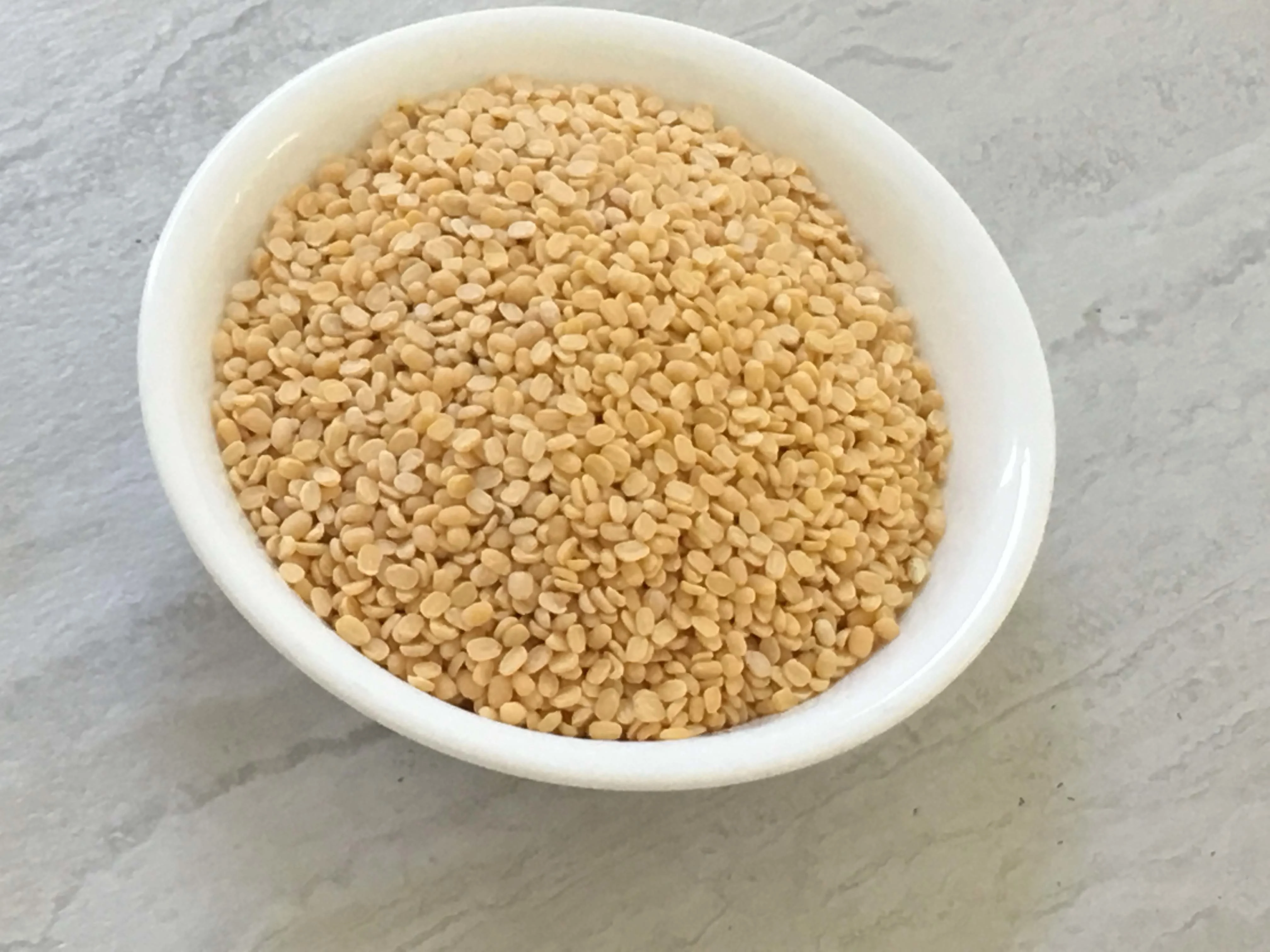
Split Mung Beans
All right I am back, after a well deserved nap my brain cells seem to be recovering from the sugar induced stupor! If I make any mistakes – well you know where the blame lies .
These tiny beans are the star of this desert. There is a little prep work involved. Wash and dry the beans on layers of kitchen towels. A quick wash is all you need, and absolutely no soaking. You can skip this step if very sure of the quality of the beans. The other step is to extract the coconut milk. I prefer to use fresh coconut milk, especially during special occasions, but you can get away with canned or powdered versions as well. If using canned, use the full fat variety. Do not shake the can, and skim off 1 tbsp of the solids and mix with 1 C water for thin coconut milk. Mix 2 to 3 Tbsps of the cream with 1 C water to make medium coconut milk. Reserve the remaining cream for later.
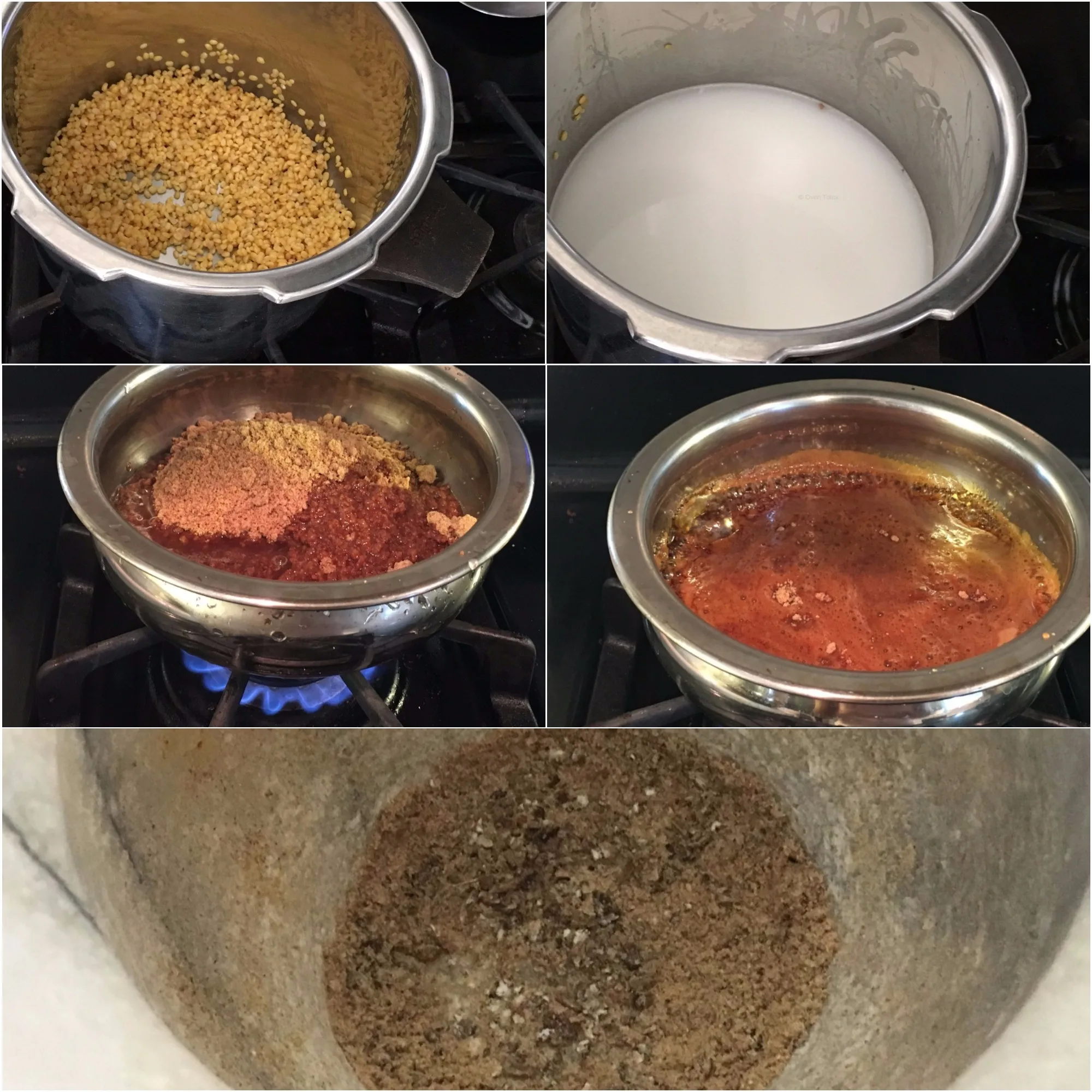
Cook 1 C mung beans with thin coconut milk and 2 C water to until it is almost all the way cooked. It used to be slow cooked over wooden fires, but I prefer my way – pressure cook for 1 whistle. You could use any thick bottomed pan at least large enough to contain 3 times the volume (about 12 C in this case). Use a large pot for this dish to avoid accidental spills, boiling over etc. .
While the beans are cooking break the jaggery into small pieces. In a pan add the jaggery with 1/4 c water and bring to slow boil. Let it caramelize a little before adding 1/2 to 3/4 C more water. Stir to help all the jaggery dissolve into the water. bring it to a slow simmer and turn off the heat. Keep warm. Crush the aromatic spices and set aside. I prefer to use whole spices, rather than powders.
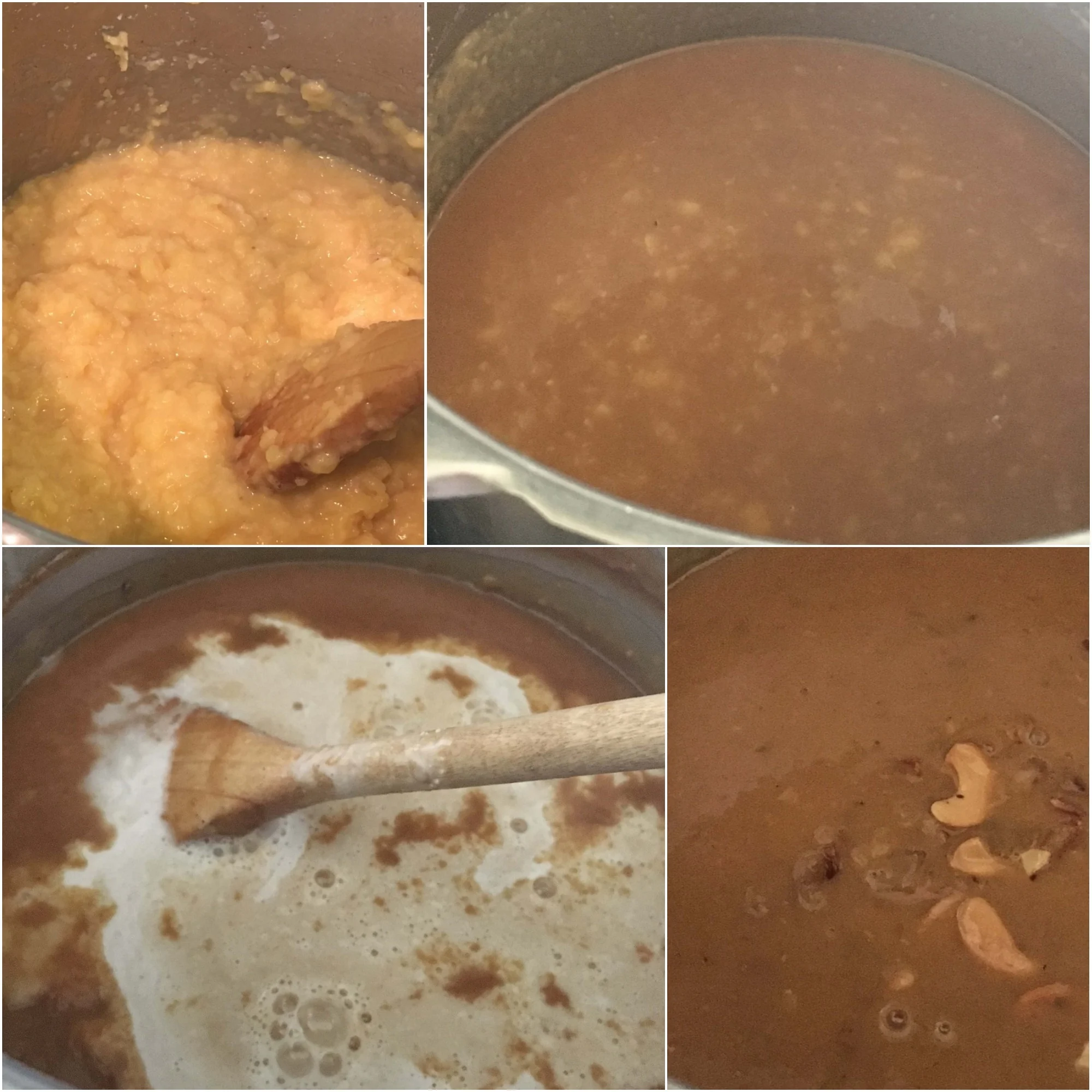
Mash the cooked dal lightly and add the medium thick coconut milk and half the melted jaggery into it. Since it is unprocessed and raw, the sweetness of jaggery varies. I start with 1/2 the quantity and add the left over as needed. Bring it back to boil and slow simmer for 10 minutes .Taste and add more jaggery as needed. Simmer until it thickens to desired consistency.
Add the spice mix stir and add the thick coconut milk. Mix well and bring to a slow simmer, do not boil . Turn off the heat. Fry the coconut pieces, cashew nuts and raisins one by one in a little ghee (or coconut oil for vegans). Add the fried pieces into the payasam reserving a few pieces for garnishing. Stir well and cover with a lid and let rest for 20 to 30 minutes. Pradhaman tends to thicken a little as it rests.
Serve !!
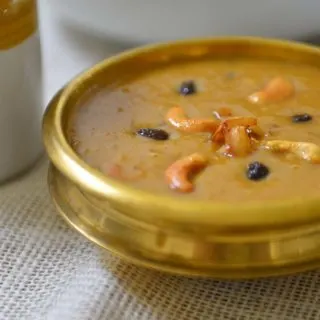
Parippu Pradhaman
Ingredients
- 1 C Mung Dal Split
- 500 g Jaggery 1lb (See Notes)
- 1 Coconut ( or equivalent see notes )
- 1/4 Tsp Cumin Seeds
- 1/4 Inch Dry Ginger About 1 Tsp Powdered
- 4 Cardamom
- 15 Cashew Nuts
- 2 Tbsp Raisins
- 2 Tbsp Coconut Pieces
- 1 - 2 Tbsp Ghee / Coconut Oil
Instructions
- Grate 3/4 of the the coconut and extract coconut milk - 1/2 C first extraction, 1 1/2 C second and third extractions. See notes if using canned milk.
- Heat in a heavy bottom pan or in a pressure cooker. Add the Parippu (mung dal) and dry roast for a few minutes until it changes color and gives off a nice roasted aroma. Add enough water to the thin coconut milk to make up 3 cups. Pour this over the roasted parippu , cover with a lid and cook till done. In a pressure cooker cook for 1 whistle.
- While the dal is cooking, crush the jaggery. Put it in a thick bottomed pan along with 1/4 C water. Heat over low heat and let the jaggery melt and begin to caramelize (avoid this step if lighter colored pradhaman is desired or if the jaggery is already dark colored). Add about 1/2 c water to the melted jaggery and stir well. Heat over medium heat until the jaggery is dissolved completely. If needed add more water. Turn off the heat strain and keep warm.
- Add half of the jaggery liquid to the cooked parippu along with the second extraction of coconut milk. Bring to a boil and allow to simmer for 10 minutes. Stir in between to keep the pradhaman from sticking to the bottom .
- Taste and add as much more of the remaining jaggery liquid as per your taste. Add more water if the pradhaman seems thick. Simmer for a few more minutes, until the pradhaman has reached desired consistency.
- Take a mortar and pestle and crush the cumin, dry ginger and cardamom to coarse powder.
- Add the thick coconut milk, mix well and turn off the heat . Do not boil the pradhaman. Add the spice mix to the pradhaman and let rest for a few minutes. Pradhaman tends to thicken a little as it rests.
- Heat Ghee in a kadai or small frying pan. Fry cashew nuts till browned evenly. Drain and reserve. Repeat the process with raisins and coconut pieces. Reserve a little of the fried pieces for garish and add the rest to the pradhaman. Mix well and rest for 30 minutes.
- When ready to serve , transfer to serving containers and garnish with the remaining fried bits.
Notes
- If using canned milk - use full fat variety.
- If using canned milk use the cream settled on top as follows - thin 1 Tbsp coconut cream with 1C water and use as the 3rd extraction coconut milk. Thin 2 to 3 tbsp coconut cream with 1C water for 2nd extraction coconut milk. Finally use the cream as thick coconut milk.
- Adjust spices to your taste, the ginger and cumin are traditionally added to help with digestion.
- For vegan version use coconut oil, though traditionally ghee is used.
- When Jaggery is not available use a mix of brown sugar and molasses. Sweeten as needed with brown sugar and add about 1 Tbsp of molasses for the recipe above.
Important: Nutrition Values are estimates. Actuals vary based on ingredients and serving size.
The idea is to get the same slow cooked taste in less time . Now obviously there is no substitute for the slow cooked feel over the wood burning stove , but a few tips and tricks will approximate the taste. The traditional pan for making pradhaman is Uruli – a thick shallow wok without the long handle. Uruli is designed to perform best over traditional wood burning stoves where the flames could dart all around the base. A pressure cooker gets the job done in much less time.
- The design of the Uruli makes it easy for the solids to get attached to the sides caramelize a little ,intensifying the flavor profile. The repeated stirring scrapes the bits that stick to the sides back into the liquid. This is the reason I recommend letting the jaggery melt first.
- While melting the jaggery a little bit of water is added initially to prevent burning.
- Cook the dal in thin coconut milk – this helps with the flavors to meld more uniformly.
- Restaurents add sago or tapioca pearls to the pradhaman as a thickener. This is not a standard practice for traditional Kerala celebrations .
- The same recipe can be used with other dals – kadala parippu payasam or chana dal (split peas) is very popular as well. Add 1 to 2 tsp ghee/oil while roasting split peas.
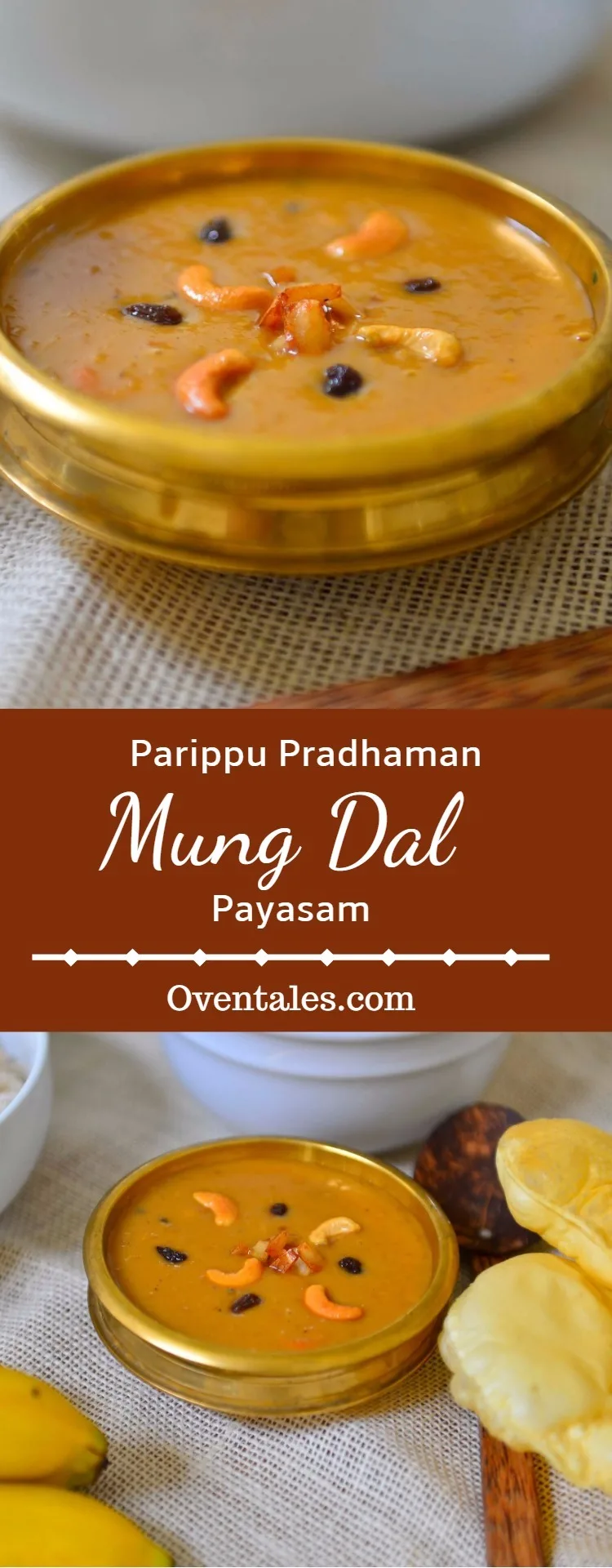

Onam in God’s own country – With Words
Wednesday 26th of August 2020
[…] Paripu payasam […]